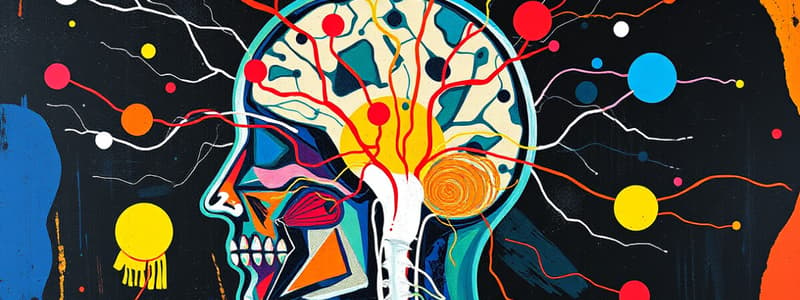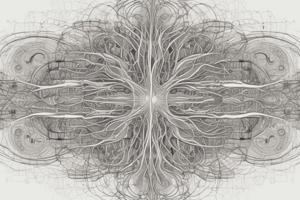Podcast
Questions and Answers
What type of receptor is responsible for detecting physical signals such as pressure and stretch?
What type of receptor is responsible for detecting physical signals such as pressure and stretch?
- Photoreceptors
- Nociceptors
- Thermo receptors
- Mechano receptors (correct)
Which division of the peripheral nervous system is responsible for voluntary movements?
Which division of the peripheral nervous system is responsible for voluntary movements?
- Autonomic nervous system
- Motor division
- Somatic nervous system (correct)
- Sympathetic division
What type of neuron is most commonly found and characterized by one axon and multiple dendrites?
What type of neuron is most commonly found and characterized by one axon and multiple dendrites?
- Unipolar neurons
- Multipolar neurons (correct)
- Bipolar neurons
- Pseudo unipolar neurons
Which type of glial cell provides structural support and regulates the transmission of nutrients in the central nervous system?
Which type of glial cell provides structural support and regulates the transmission of nutrients in the central nervous system?
What is the function of Schwann cells in the peripheral nervous system?
What is the function of Schwann cells in the peripheral nervous system?
What is the primary role of the sodium-potassium pump in neurons?
What is the primary role of the sodium-potassium pump in neurons?
Which type of conduction occurs when signals jump between myelin sheaths?
Which type of conduction occurs when signals jump between myelin sheaths?
What is the resting membrane potential typically measured at in neurons?
What is the resting membrane potential typically measured at in neurons?
Flashcards are hidden until you start studying
Study Notes
Nervous System Overview
- Sensory Input: Involves receptors converting stimuli into signals. Types include:
- Mechanoreceptors: Detect pressure and stretch.
- Photoreceptors: Respond to light.
- Thermoreceptors: Sense temperature changes.
- Chemoreceptors: Monitor taste and internal chemical changes.
- Nociceptors: Alert to tissue damage.
Integration and Control
- Integration Centers: Brain and spinal cord integrate sensory input and control responses.
- Spinal Cord Function: Mediates reflex responses, e.g., pulling away from a hot object.
- Regulatory Glands: Includes pancreas, adrenal glands, and pineal glands.
- Homeostasis: Maintains stable internal conditions, with thermoreceptors influencing the hypothalamus.
Nervous System Structure
- Central Nervous System (CNS): Comprises the brain and spinal cord.
- Peripheral Nervous System (PNS): Divided into motor and sensory divisions.
- Somatic Nervous System: Manages voluntary muscle movements.
- Autonomic Nervous System: Governs involuntary activities with two branches:
- Parasympathetic Division: Slows bodily functions.
- Sympathetic Division: Prepares the body for stress responses.
Neural Anatomy
- Cranial and Spinal Nerves:
- 12 pairs of cranial nerves.
- 31 pairs of spinal nerves (8 cervical, 12 thoracic, 5 lumbar, 5 sacral, 1 coccygeal).
- Neurons: Key components include:
- Dendrites: Receive signals.
- Axon: Transmits impulses, terminates at synapses with other neurons.
- Soma (Cell Body): Contains the nucleus.
- Axon Hillock: Site where action potentials (AP) are generated.
- Types of Neurons:
- Unipolar: Rare in adults.
- Bipolar: Typically sensory neurons.
- Pseudounipolar: Found in sensory pathways (e.g., fingers).
- Multipolar: Most common neuron type, with one axon and multiple dendrites.
Myelination and Signal Conduction
- Myelinated vs. Unmyelinated Axons:
- Myelination: Increases conduction speed and offers protection. Myelination is provided by:
- Oligodendrocytes: In the CNS, can myelinate multiple axons.
- Schwann Cells: In the PNS, myelinate a single axon.
- Myelination: Increases conduction speed and offers protection. Myelination is provided by:
- Saltatory Conduction: Action potentials jump between myelin sheaths via ion channels, enhancing speed.
Glial Cells Functions
- CNS Glial Cells:
- Astrocytes: Provide nutritional support and structural integrity.
- Oligodendrocytes: Myelinate CNS axons.
- Ependymal Cells: Line ventricles, aid in production of cerebrospinal fluid (CSF) using cilia.
- Microglia: Act as immune responders, removing debris and aiding cognitive development.
- PNS Glial Cells:
- Satellite Cells: Support neuronal cell bodies.
- Schwann Cells: Myelinate peripheral nerves.
Membrane Potentials and Transport Mechanisms
- Resting Membrane Potential: Typically -70 mV, established by ionic concentration gradients and permeability.
- Transport Mechanisms:
- Simple Diffusion: Passive movement across cell membranes.
- Channel-Facilitated Diffusion: Uses protein channels for specific ions.
- Carrier-Facilitated Transport: Involves specific carriers for substances.
- Sodium/Potassium Pump: Moves 3 Na⁺ out and 2 K⁺ in, essential for maintaining resting membrane potential and nerve impulse transmission.
- Leak Channels: Allow passive ion flow, contributing to membrane potential stability.
Studying That Suits You
Use AI to generate personalized quizzes and flashcards to suit your learning preferences.




